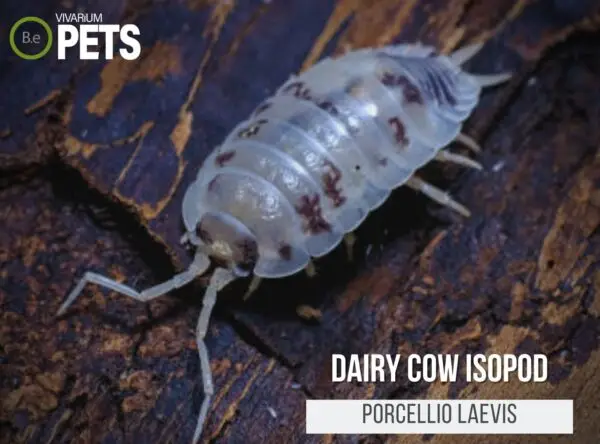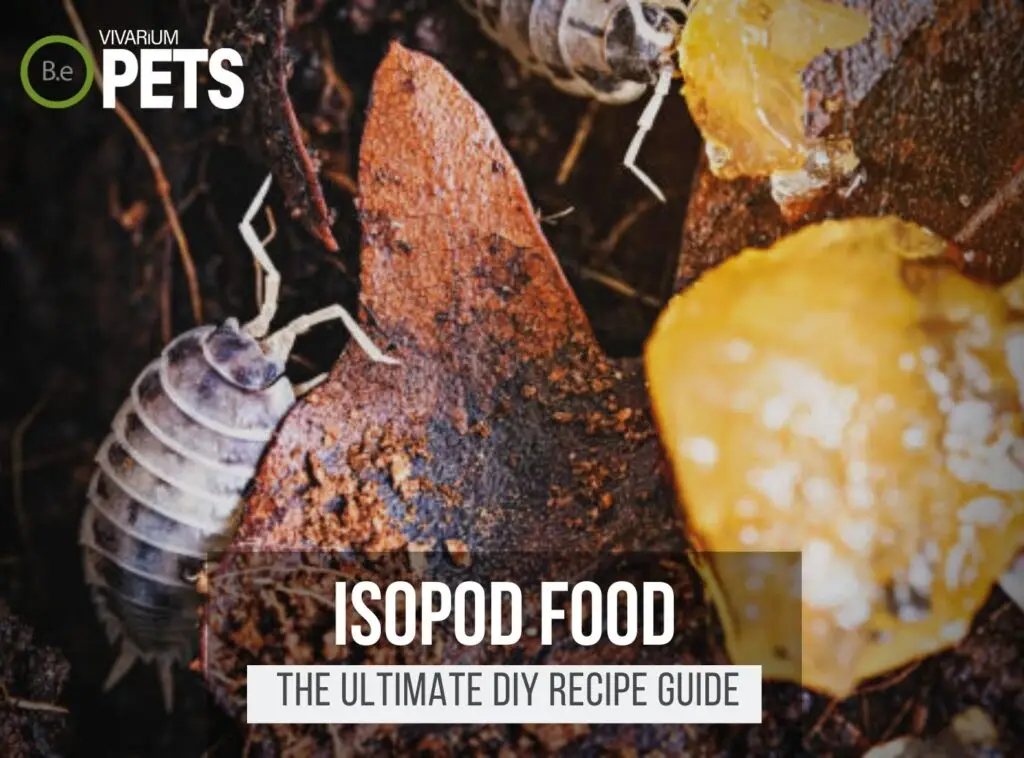Let’s say you want to make a farmstead-themed terrarium, all you’d need is some farmhouse decor and “Livestock” critters like Dairy Cow Isopods (Porcellio laevis).
These unusual animals, originating from Southern, Central, and Northern Europe, are fascinating creatures and make great pets.
Although they may look intimidating, they are quite easy to take care of and make an interesting addition to any home.
In this guide, we’ll explain all you need to know about these farmland pets and provide tips on creating an optimal environment for them.
So, if you’re interested in discovering more about these fascinating sow bugs, read on!
Table Of Contents:
ToggleWhat Are Dairy Cow Isopods?
Porcellio laevis are a small species of crustacean in the family of Porcellionidae.
They are often referred to as ‘arthropods’ due to their hard, exoskeleton and segmented bodies.
Their common name, Dairy Cow Isopods, is derived from their unique resemblance to cows in the sense that their stripes resemble a cow’s hide.
Create an ideal habitat for your Dairy Cow Isopods with our Customizable Isopod Terrarium Kits, which include everything you need to get started.
What Do Dairy Cow Isopods Look Like?
Dairy Cow Isopods are usually between 1.5 – 2.4cm in length and have oval bodies composed of seven segments with seven pairs of jointed legs.
Their colors range from yellow to brown, depending on the environment they are kept in.
They also have two antennae protruding from their head which act as sensory organs for their environment.
The tail area has two sets of pleopods which are used for swimming or crawling.
These crustaceans also have sharp claws which help them tear apart their food, forage for material, and defend themselves.
Benefits Of Using Dairy Cow Isopod
Using Porcellio laevis in vivariums is a great way to create a natural, self-sustaining ecosystem.
Dairy Cow Isopods are an important part of any bioactive terrarium setup, as they help to break down organic matter, aerate the substrate, and keep detritivores in check, making them a key part of the food chain.
They are also good for cultivating enough organic matter for other detrivores, such as land snails and millipedes, to feed on.


Dairy Cow Isopod Facts
Dairy Cow Isopods are a species of woodlice that are native to Southern Europe and North Africa.
They are incredibly hardy, with a natural diet of fungi, decaying leaves, and rotting wood, and typically live for many years.
Porcellio laevis very easily breed in captivity, with the female carrying her eggs until they are ready to hatch.
Dairy Cow Isopods make excellent pets because of their low maintenance and amusing nature.
Habitat
Porcellio laevis are terrestrial crustaceans that are native to Europe and Northwest Africa.
Dairy Cow Isopods have adapted to a wide variety of habitats, ranging from fields and meadows to forests and swamps.
In their natural environment, they hide in moist and shady places under logs, rocks, and loose soil.
These isopods are capable of burrowing and creating tunnels. This is one of their adaptations that allows them to survive in various climatic conditions and elevations.
They are also capable of adapting to different terrains and soil compositions.
This is how they spread to other parts of the world, such as North and South America, Australia, and New Zealand.
Replicate their natural habitat perfectly with our Bioactive Isopod Substrate Blend, designed to provide the ideal moisture and organic content for your isopods.
Diet
Dairy Cow Isopods are detritivores and typically feed on decaying vegetation as well as other organic matter found in their natural habitat.
They mainly graze on grasses, as well as decaying wood, leaf litter, and other plant matter.
Porcellio laevis also eats fruits and vegetables when they find them, making them heedless scavengers.
In addition, they will feed on fungi, mosses, and lichens growing on trees and rocks.
Temperament
Dairy Cow Isopods are generally quite gentle and docile critters, with no known hostile behaviors.
They rarely charge in the direction of another animal unless provoked, and even then it’s very rare for them to bite.
They typically retreat after coming in contact with humans or other creatures, making them an excellent choice of pet around children.
These isopods seem to be very social creatures and can often be seen interacting with each other in their terrariums.
They do not do well in solitude, and it’s important to keep them in groups of at least three so that they have plenty of company.
As with other isopods, Dairy Cow Isopods become more active and social when kept in a group.
Lifespan
The life cycle of a Dairy Cow Isopod begins with an egg that hatches into a tiny isopod larva. This larva then goes through several molting stages before reaching adulthood.
During each molt, the isopod grows in size and eventually becomes an adult. At the adult stage, the isopod will reproduce and lay eggs to complete the life cycle.
Given proper care and healthy habitat, Dairy Cow Isopods have the potential to live up to two years or more.
To ensure they live a long and healthy life, owners must provide a clean environment with appropriate humidity and temperature levels.
Breeding
Dairy Cow Isopods mate and reproduce using a courtship ritual between male and female isopods.
The ritual starts with the male trying to get the female isopod to turn around after the male has positioned himself behind her.
If the female does turn around the male will proceed with their courtship further by touching the female’s antennae, or tail.
The male will then deposit sperm onto the female while they position themselves belly to belly at a 90-degree angle.
Afterward, the female will lay her eggs in a moist chamber, typically being either the soil, a peat moss lining, or a designated nesting chamber.
The eggs mustn’t be exposed to dry conditions as this will decrease their chance of hatching.
Typically the eggs will hatch within 7-30 days and the young isopods will begin to develop.
It can take 8-14 weeks for the isopods to reach maturity and every 6-8 weeks after that they will molt and develop further.
Where To Find Dairy Cow Isopod
Dairy cow isopods are an interesting species of terrestrial isopods that are found in the wild or purchased from pet stores or online retailers.
When searching for dairy cow isopods in the wild, they are sometimes found hiding under rocks and logs and in crevices.
They may also be found in systems of underground burrows, which also offer entry points for potential predators.
When buying dairy cow isopods from pet stores or online retailers, it is important to make sure that they are healthy and safe for use as pets.
Once these precautions are taken, they can usually be purchased in bulk or small groups.
For those looking to breed them, multiple males and females can be purchased to form larger colonies.
Dairy Cow Isopod Care
Porcellio laevis are a popular pet to keep, requiring an environment with controlled temperature and humidity.
They also need a consistent food source and occasional monitoring and adjustments. Breeding is possible with a separate habitat.
Symptoms of illness can happen if they are not cared for properly; if signs of illness arise, troubleshooting should be done to try and fix it right away.
Tank Requirements
The ideal tank conditions for Dairy Cow Isopods are a tropical terrarium that is at least 5 to 10 gallons in size, with a slightly acidic to neutral pH of around 7.0-7.5, a hardness rating of 3-18dGH.
An ideal temperature of around 68°F-80°F, a substrate of moistened terrarium soil, and low to moderate levels of timed terrarium lighting are also recommended.
Dairy Cow Isopods are best kept in an enclosure with a vented top that allows an exchange of air to reach them, and it should also have a tight-fitting lid to prevent escape.
Proper substrate and ventilation are also vital for their survival, as they need a damp habitat to stay hydrated, and must have a balance of humidity and oxygen to breathe.
What Do Dairy Cow Isopods Eat?
Dairy Cow Isopods are easy to feed and require little maintenance, although their dietary needs must be met to ensure their health and well-being.
Things You Can Feed Your Dairy Cow Isopods:
- Various fruits and vegetables. Examples include lettuce, apples, carrots, oranges, cucumbers, and potatoes.
- Fruits, vegetables, and grains that have been dried.
- Algae wafers
- Fish flakes
- Commercial isopod food
If you’re more of an avid hobbyist like myself, be sure to check out my ultimate DIY Isopod food guide. I give a more in-depth explanation of the best foods and my favorite recipe.
Best Tankmates For Dairy Cow Isopod
When it comes to tankmates for Dairy Cow Isopods, several other invertebrates are beneficial to keep with them.
These include springtails, worms, and snails. All of these tankmates benefit from the presence of Porcellio laevis in their habitats.
Combined, they help to keep the soil moist and prevent populations of pests from overwhelming the environment.
In addition, these tankmates can provide food for the Dairy Cow Isopods, helping to keep them healthy and well-nourished.
Outside of these invertebrates, other species of isopods can be kept with Dairy Cow Isopods as well. These include both Cubaris and Armadillidium isopods.
These animals help to provide a sense of natural balance to the tank, while also being beneficial in terms of cleaning up after the isopod waste and providing additional food sources.
Conclusion
Many people are unaware that Dairy Cow Isopods are an excellent pet option. They are easy to care for and require minimal maintenance.
With the proper environment, nutrition, and monitoring, Porcellio laevis can provide years of enjoyment and entertainment.
For those willing to put in the effort, these invertebrates can be a delightful addition to any miniature barnyard.
Create the ideal habitat for your isopods with our species-specific soil mixes and Insect Enclosure Kits. These products provide everything you need for a successful and thriving isopod colony.
Frequently Asked Questions
No, dairy cow isopods (Porcellio laevis) are not considered an invasive species.
Porcellio laevis feed on decaying organic matter, such as leaves, moss, and other dead plant material. They also feed on fungi, small insects and bacteria.
Dairy cow isopods (Porcellio laevis) are used for laboratory research and experiments, as well as for pet food or feed for reptiles and amphibians. Some hobbyists prefer to keep them as pets as well.
The average life span of a dairy cow isopod is approximately 1 to 2 years.
No, dairy cow isopods do not eat each other. However, if they are overcrowded or starving they may turn to eating the smaller ones in the bunch.
No, Dairy Cow Isopods (Porcellio Laevis) do not bite.








